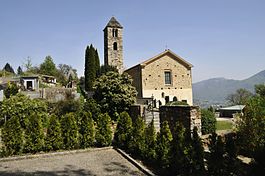Cademario
| Cademario | ||
|---|---|---|

Parish church of Sant'Ambrogio in Cademario
|
||
|
||
| Coordinates: 46°1′N 8°54′E / 46.017°N 8.900°ECoordinates: 46°1′N 8°54′E / 46.017°N 8.900°E | ||
| Country | Switzerland | |
| Canton | Ticino | |
| District | Lugano | |
| Government | ||
| • Mayor | Sindaco | |
| Area | ||
| • Total | 3.96 km2 (1.53 sq mi) | |
| Elevation | 792 m (2,598 ft) | |
| Population (Dec 2015) | ||
| • Total | 759 | |
| • Density | 190/km2 (500/sq mi) | |
| Postal code | 6936 | |
| SFOS number | 5161 | |
| Surrounded by | Alto Malcantone, Aranno, Bioggio, Iseo | |
| Website |
www SFSO statistics |
|
Cademario is a municipality located in the district of Lugano in the Swiss canton of Ticino. Bordering municipalities are Aranno, Bioggio and Iseo, in the Alto Malcantone area.
Cademario is first mentioned in 1163 as Cademerio. In 1335 it was mentioned as Cadelmario Superiore to distinguish it from Cadelmario Inferiore, which is now Bosco Luganese.
The oldest trace of a settlement in the area was an Iron Age cemetery which was discovered at La Forcora. By 1000 the Bishop of Como owned property and rights in the village. Later, some of these rights were transferred to the Benedictine Abbey of S. Abbondio in Como. Originally, the municipality was much larger. It included the villages of Bosco Luganese (now part of Bioggio), which separated in 1783, Bioggio and perhaps Gaggio.
The old parish church was built in the Early Middle Ages at a site below the village. Over the centuries the church was rebuilt numerous times. It was enlarged and rebuilt, new frescoes were added, and it was even re-aligned from the southeast to the north. The current building was built in the early 17th century, but it was also later enlarged. It was last consecrated in 1833. The parish archive contain a number of records from the Middle Ages, including town charters from 1416 and 1474.
Throughout its history, the slopes around the village were planted with vineyards. In 1990, the vineyards covered an area of 600 hectares (1,500 acres), with about 22,000 vines. There used to be a settlement at Alp Agra, but it was abandoned and all the buildings are gone. In the 1920s, the majestic Kurhaus or medicinal spa, was built above the village.
...
Wikipedia




